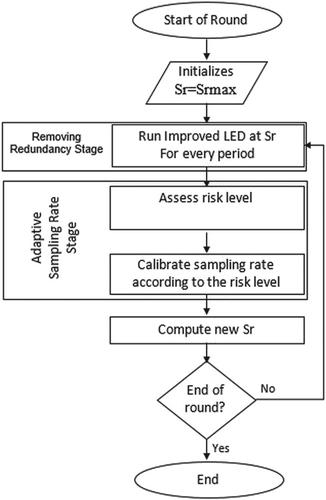当前位置:
X-MOL 学术
›
Int. J. Commun. Syst.
›
论文详情
Our official English website, www.x-mol.net, welcomes your
feedback! (Note: you will need to create a separate account there.)
Adaptive rate energy‐saving data collecting technique for health monitoring in wireless body sensor networks
International Journal of Communication Systems ( IF 1.7 ) Pub Date : 2020-08-21 , DOI: 10.1002/dac.4589 Alaa Shawqi Jaber 1 , Ali Kadhum Idrees 2
International Journal of Communication Systems ( IF 1.7 ) Pub Date : 2020-08-21 , DOI: 10.1002/dac.4589 Alaa Shawqi Jaber 1 , Ali Kadhum Idrees 2
Affiliation

|
One of the best and cheapest solutions for continuous and remote monitoring and evaluation of patient health is to use the WBSNs (wireless body sensor networks) due to its great role in decreasing the expenses of the health care system. In this type of network, the sensed vital signs are gathered by biosensor devices then transmitted to the coordinator for further processing and fusion. Since the limited resources for biosensor devices (energy, memory, and processing) in addition to the periodic transmission for the large volume of data, it is essential to optimize the data transmission to save energy while keeping the data accuracy at the coordinator. This work suggests an AREDaCoT (adaptive rate energy‐saving data collecting technique) which aims to energy‐efficient patient health monitoring in periodic WBSNs. The AREDaCoT works in terms of so‐called periods. Each period has two stages: removing redundancy and adapting the sampling rate. The first stage uses improved LED to remove the redundancy in measurement of vital signs, whereas the second stage applies two techniques, assesses the risk score according to the risk level of the patient and the CSr (calibrate sampling rate) fittingly with different ranges of risk level for the sensor sampling ratio to be adapted. The performance of AREDaCoT has been evaluated in light of multiple series of simulations on real health datasets being compared to an existing approach. The acquired results illustrate how AREDaCoT decreases the volume of gathered data; thus, a significant energy saving has been made whilst preserving data accuracy and integrity. Moreover, the percentage results of data reduction over the original data set and the score differences between them are both acceptable.
中文翻译:

无线人体传感器网络中用于健康监测的自适应速率节能数据收集技术
连续和远程监测和评估患者健康状况的最佳和最便宜的解决方案之一是使用WBSN(无线人体传感器网络),因为它在降低医疗保健系统的费用方面起着重要作用。在这种类型的网络中,生物传感器设备收集感测到的生命体征,然后将其传输到协调器以进行进一步处理和融合。由于除了用于大量数据的定期传输外,生物传感器设备的资源(能源,存储和处理)资源有限,因此有必要优化数据传输以节省能源,同时保持协调器的数据准确性。这项工作提出了一种AREDaCoT(自适应速率节能数据收集技术),旨在对定期WBSN进行节能的患者健康监测。AREDaCoT按照所谓的周期工作。每个周期都有两个阶段:消除冗余和调整采样率。第一阶段使用改进的LED消除生命体征测量中的冗余,而第二阶段应用两种技术,根据患者的风险水平和适合不同风险范围的CSr(校准采样率)评估风险评分传感器采样率的水平。AREDaCoT的性能已根据与现有方法进行比较的对真实健康数据集的多个模拟系列进行了评估。获得的结果说明了AREDaCoT如何减少收集到的数据量。因此,在保持数据准确性和完整性的同时,已经大大节省了能源。此外,
更新日期:2020-10-16
中文翻译:

无线人体传感器网络中用于健康监测的自适应速率节能数据收集技术
连续和远程监测和评估患者健康状况的最佳和最便宜的解决方案之一是使用WBSN(无线人体传感器网络),因为它在降低医疗保健系统的费用方面起着重要作用。在这种类型的网络中,生物传感器设备收集感测到的生命体征,然后将其传输到协调器以进行进一步处理和融合。由于除了用于大量数据的定期传输外,生物传感器设备的资源(能源,存储和处理)资源有限,因此有必要优化数据传输以节省能源,同时保持协调器的数据准确性。这项工作提出了一种AREDaCoT(自适应速率节能数据收集技术),旨在对定期WBSN进行节能的患者健康监测。AREDaCoT按照所谓的周期工作。每个周期都有两个阶段:消除冗余和调整采样率。第一阶段使用改进的LED消除生命体征测量中的冗余,而第二阶段应用两种技术,根据患者的风险水平和适合不同风险范围的CSr(校准采样率)评估风险评分传感器采样率的水平。AREDaCoT的性能已根据与现有方法进行比较的对真实健康数据集的多个模拟系列进行了评估。获得的结果说明了AREDaCoT如何减少收集到的数据量。因此,在保持数据准确性和完整性的同时,已经大大节省了能源。此外,











































 京公网安备 11010802027423号
京公网安备 11010802027423号